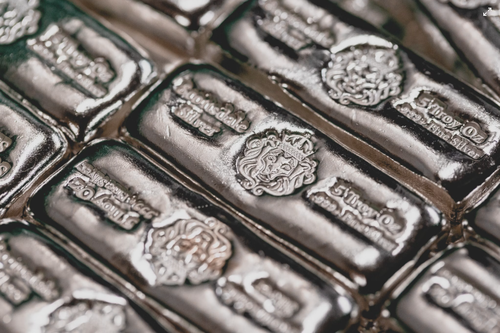Today's Gold and Silver News: 17-04-2025

Silver Price News: Silver Holds Steady Above $32 an Ounce
Silver prices remained steady on Tuesday, hovering between $32.14 and $32.57 an ounce, with minimal movement compared to Monday's range of $31.92 to $32.45. This stability comes as gold prices also held steady just below their recent all-time highs, signalling a period of consolidation in the precious metals market. Silver's performance largely mirrored that of gold, which had recently hit a record price of $3,247 per ounce on April 11. The market has been influenced by political and economic uncertainty, particularly regarding U.S. tariffs and the subsequent pause on new tariffs, which have caused volatility and prompted investors to seek the safety of precious metals.
From a technical standpoint, silver's price remains just below its 20-day moving average of $32.54 an ounce, while support is found around $31.90. On the upside, resistance is observed at $32.81. The market is currently in a "wait-and-see" mode, with the 10-day Relative Strength Index indicating a neutral outlook. Upcoming events, including U.S. retail sales data, and central bank rate decisions from the Bank of Canada and the European Central Bank, are expected to influence market sentiment. Traders are particularly focused on potential interest rate cuts by the U.S. Federal Reserve in the coming months, which could further impact the precious metals market. Source
Gold Price News: Gold Steady as Markets Assess Tariffs Impact
Gold prices remained steady on Tuesday, trading within a narrow range of $3,200 to $3,233 per ounce, just below the recent all-time high of $3,247 set on April 11th. This stability comes as the markets continue to assess the impact of U.S. trade policies, particularly the recent uncertainty surrounding tariff increases. U.S. President Donald Trump’s decision to pause tariff hikes on most countries for 90 days has left markets uncertain about the future of global trade, compounded by ongoing tensions between the U.S. and China. As a result, investors have increasingly turned to gold as a safe haven asset, though the administration’s potential exemptions on certain goods have somewhat alleviated fears of severe economic repercussions.
In addition to trade concerns, expectations of potential U.S. Federal Reserve interest rate cuts are also supporting gold prices. Market sentiment currently suggests a high likelihood of the Fed keeping rates unchanged in its upcoming May meeting, with a stronger chance of a 25-basis-point rate cut in June. Looking ahead, upcoming economic data, including U.S. retail sales figures and central bank meetings in Canada and Europe, will be closely monitored. The Bank of Canada is expected to maintain its rate at 2.75%, while the European Central Bank is anticipated to lower rates by 15 basis points to 2.4%. These events could influence gold prices further, as they will provide more insight into global economic conditions and monetary policies. Source
Gold's surge to record highs offers investors a unique opportunity amid market uncertainty
Gold's recent surge to all-time highs above $3,200 an ounce offers investors a unique opportunity to capitalize on weaknesses in equity markets, according to Jerry Prior, COO of Mount Lucas Management. He believes gold will remain well-supported, even if its prices have entered overbought territory. The rally in gold prices comes amid global uncertainty, with factors such as the ongoing war in Ukraine and unpredictable economic policies making long-term planning difficult. Despite this uncertainty, Prior does not consider gold overvalued, stating that it is appropriately priced based on current conditions, but he acknowledges that market conditions could change rapidly.
Prior also highlighted the importance of portfolio rebalancing, particularly for gold investors who have seen significant profits this year, with gold up 22% in 2025 and 37% in the past 12 months. He suggested that investors could take profits from their gold holdings if their allocation has increased beyond the target of 10%, and consider reallocating those gains into other markets. However, Prior cautioned that the market volatility is high, making it difficult to predict outcomes for equity markets like the S&P 500, which could range significantly between 4,400 and 7,000. In this environment, Prior recommended maintaining a diversified portfolio and taking a more passive approach, such as focusing on activities like golf, to avoid getting too caught up in the daily market fluctuations. Source
Will the Fed delay lowering rates this year?
While President Trump remains optimistic about the economic outlook, citing recent favourable inflation data, economists are increasingly focused on how ongoing trade tensions and tariffs will impact GDP growth and inflation. March inflation figures showed a slight decrease in both CPI and core CPI, which might suggest room for the Federal Reserve to consider rate cuts. However, Fed Chairman Jerome Powell has been cautious, emphasizing the need for more clarity, particularly regarding the long-term effects of tariffs. Although inflation appears under control for now, the full impact of tariffs—essentially taxes on imports—has yet to be felt, and the cost of imported goods could eventually push prices higher, especially if companies pass on these costs to consumers.
The situation is further complicated by other factors, such as a weak dollar, which makes imports more expensive, and the potential for reduced competition as foreign companies scale back their U.S. presence. Even if companies move production back to the U.S., the costs associated with new factories, supply chain restructuring, and increased demand for construction materials could continue to push prices up. As a result, inflation expectations for the next year have risen significantly. Although there is hope that these price increases will be temporary, the ongoing uncertainty around tariffs and trade policy changes may force the Fed to keep interest rates higher for longer, complicating the economic outlook and delaying any potential rate cuts. Source
China’s gold market was strong in March as prices and investment increased while imports and jewelry demand fell – World Gold Council
China’s gold market demonstrated notable strength in March and through the first quarter of 2025, driven by high domestic gold prices, increased ETF inflows, and continued central bank purchases. While gold prices surged to all-time highs, geopolitical tensions, particularly regarding trade policies and the weak dollar, contributed to gold’s appeal as a safe-haven asset. This led to significant inflows into Chinese gold ETFs, with RMB16.7 billion (US$2.3 billion) flowing in during Q1, a record for the country. Additionally, China’s sovereign gold reserves increased by 2.8 tonnes in March, continuing a trend of gold purchases by the People’s Bank of China. However, the rally in gold prices had a negative impact on wholesale gold demand, which was 29% below the ten-year average, and jewelry demand, which suffered from the high price levels.
The surge in gold prices also caused a downturn in gold imports, which began to slow in early 2025, reaching their lowest point in January since 2021. This was primarily due to weaker domestic gold demand and price discounts in the local market, alongside fewer working days due to the Chinese New Year holiday. While imports rebounded somewhat in February, they remained well below the 2024 monthly average. Looking forward, the World Gold Council expects strong investment demand for gold to persist, fuelled by escalating trade tensions between the U.S. and China and the ongoing volatility in global markets. This continued demand for gold is likely to be supported by global price strength, with insurers entering the market further bolstering long-term investment prospects, although jewelry demand remains uncertain due to the high price levels. Source
Gold prices holding firm above $3,300 after U.S. retail sales rise 1.4% in March
Gold prices have surged to new all-time highs above $3,300 an ounce, holding steady despite stronger-than-expected U.S. retail sales data for March. Retail sales rose 1.4%, surpassing forecasts, while core sales (excluding vehicle purchases) also increased by 0.5%. Despite the resilience of U.S. consumers, some economists attribute the recent boost in sales to front-loading ahead of upcoming global tariffs. While the retail data indicates robust consumption, analysts warn that rising global tariffs could eventually impact spending. Despite this, gold continues to be driven by momentum, with prices remaining high amidst growing concerns about potential recession risks. Source
A historical milestone: Gold futures closes above $3,350

Image Source: Kitco News
Gold futures have reached a historic milestone, surpassing $3,350 for the first time, fueled by a perfect storm of economic factors. The surge, particularly evident in the June 2025 gold futures contract, saw a remarkable $256 gain over three days, marking a dramatic recovery after a previous price drop. The latest rise, with a $110 increase in a single day, has brought gold to an all-time high of $3,354.40, reflecting the increasing demand for the precious metal amid geopolitical tensions and economic uncertainty triggered by President Trump's trade policies, specifically his import tariffs.
These tariffs, which are expected to raise consumer costs, have prompted investors to flock to gold as a safe-haven asset. While the weakening dollar has played a role in gold’s rise, the primary catalyst has been the bullish market sentiment and heightened uncertainty. U.S. equity markets are facing significant declines, with major indices such as the Dow Jones and NASDAQ experiencing steep drops. As the S&P 500 and other indices struggle with negative year-to-date performance, gold has emerged as a favored asset for protection against economic turmoil, underscoring its safe-haven status in times of instability. Source
Gold price is starting to go ‘parabolic here’ & this could be just the start, says David Erfle
Gold prices have soared past $3,200 an ounce, driven by geopolitical tensions, economic uncertainty, and aggressive U.S. trade policies, pushing investors toward safe-haven assets like gold. David Erfle, founder of JuniorMinerJunky.com, describes the price surge as "parabolic," with the market experiencing high anxiety and significant volatility. This environment, coupled with a weakening U.S. dollar and rising Treasury yields, has diminished the traditional safety appeal of Treasuries, thereby boosting gold’s appeal as an alternative. Erfle highlights the difficulties facing the U.S. Federal Reserve in managing long-term interest rates, with trillions of dollars in bonds needing to be rolled over, creating a challenge for the broader market.
In the mining sector, companies like Newmont and Agnico Eagle are seeing strong market performance, while Barrick Gold’s shift toward copper has met with skepticism. Erfle also speculates that China is accelerating its de-dollarization strategy, selling U.S. Treasuries to accumulate more gold. He notes that gold stocks, once overshadowed by trends like AI and cryptocurrency, are finally showing strong leverage to gold prices. Erfle has strategically positioned his investments with 30% in physical gold, 20% in cash, and 50% in undervalued gold stocks, which he believes will continue to perform well as the gold market evolves. Watch the podcast
Bank of Canada holds rate at 2.75% as expected, XAUCAD rises back above C$4,600/oz
The Bank of Canada (BoC) held its interest rate at 2.75% as expected, while highlighting the growing uncertainty surrounding U.S. trade policy and its potential impact on Canada's economy. The central bank noted that trade tensions, particularly with the U.S., could lead to weaker economic growth and higher inflation expectations. In response to the BoC's announcement, gold prices rose above C$4,600 per ounce. The BoC outlined two potential scenarios: one with limited tariffs that may temporarily weaken growth and keep inflation near the 2% target, and another where a prolonged trade war leads to a recession and inflation above 3%. Governor Tif Macklem emphasized that U.S. tariffs would particularly harm Canada's economy due to the close economic ties between the two nations, with a potential U.S. recession further dampening demand for Canadian exports. Source
Gold price powers to $100 daily gain, record high, on safe-haven demand
Gold prices surged by over $100 in a single day, reaching a record high of $3,345 per ounce amid escalating geopolitical tensions between the U.S. and China, which are fueling safe-haven demand. This surge in gold prices has been bolstered by both the Chinese public and the central bank increasing their gold purchases. Meanwhile, silver prices also saw solid gains, with May silver rising to $32.88. Despite the strong demand for gold, some analysts have raised concerns about the possibility of an over-crowded trade, with a Bank of America survey indicating that gold may be heavily favored by traders at the moment.
The broader market is feeling the strain of ongoing U.S.-China trade tensions, with U.S. stock indexes dipping and Nvidia's stock taking a hit after the company revealed a significant financial charge due to potential U.S. restrictions on chip sales to China. The U.S. dollar index dropped, while crude oil prices and Treasury yields increased slightly. From a technical perspective, gold futures are showing a strong bullish outlook, with key resistance at $3,400 and support around $3,300. Similarly, silver futures are on an uptrend, with resistance at $34.00 and support at $31.00. Despite concerns of a crowded trade, gold remains a favored asset in the current economic climate. Source
Gold price holds another $100 daily gain as Stockton warns of 'challenging year' for equities, eyes shift to safe-haven plays
Gold prices surged to new record highs, rising over $100 in a single day to reach $3,345 an ounce, driven by heightened geopolitical risks and escalating trade tensions, particularly between the U.S. and China. Veteran technical strategist Katie Stockton predicted that the current market volatility could signal the beginning of a challenging year for equities. She noted that long-term charts show significant breakdowns in major indices, with monthly momentum indicators now signaling sell signals for the first time in years. Stockton emphasized that this shift indicates more volatility ahead, with equities facing a tough environment, while gold remains a strong performer due to its safe-haven appeal.
Stockton's outlook remains bullish on gold, despite some short-term signs of exhaustion in its price momentum. She advised investors to continue holding gold, noting that its breakout is technically sound across all timeframes. Meanwhile, her focus is shifting to defensive sectors, with her Tactical Sector ETF moving away from technology stocks and increasing exposure to real estate, utilities, and consumer staples, along with gold and Treasuries. Stockton also expressed caution regarding the tech sector, particularly after Nvidia’s significant financial setback, and advised selling into any relief rallies. In light of potential risks, including credit spreads and continued volatility, Stockton recommended positioning defensively, favoring gold and raising cash for future opportunities. Watch the podcast
Persistent supply deficit will drive silver prices higher – Silver Institute 2025 Survey
The 2025 Silver Survey from the Silver Institute predicts that silver will experience its fifth consecutive annual supply deficit, though this year’s shortfall will be the smallest in four years. The projected deficit is 117 million ounces, driven by slightly reduced demand and a 1.5% increase in supply from higher mine output. Industrial demand for silver is expected to remain steady at 677.4 million ounces, with growth in sectors like automotive, consumer electronics, and power grid investment, partially offsetting declines in the solar power industry. Despite recent underperformance relative to gold, silver’s diverse industrial uses and the ongoing global push for electrification are expected to support long-term demand. Even if recession risks dampen some industrial demand, the metal’s resilience is anticipated to persist.
The report also highlights a recovery in investment demand for silver, with an expected 14% increase in investor exposure and a rise in physical silver demand, particularly in coins and bars, which are forecasted to increase by 7% in 2025. Despite some market volatility, silver’s price is projected to remain supported, with expectations for further price gains in the coming months. The widening gold-silver ratio, which currently sits at a multi-year high, presents a potential opportunity for investors, as silver could eventually catch up to gold. While significant price increases will be necessary to correct the supply-demand imbalance, experts predict that silver prices will continue to rise, with new cycle peaks anticipated in the near future. Source
Disclaimer: These articles are provided for informational purposes only. They are not offered or intended to be used as legal, tax, investment, financial, or any other advice.
Featured Image – Source: Unsplash

Thanks for visiting.



.png)





.png)
.png)

















